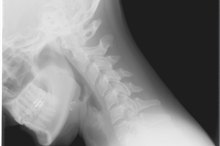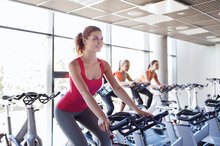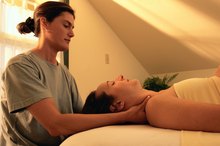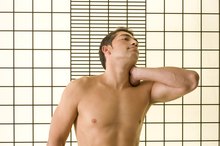Exercises & Treatments for Neck Bone Spurs
Bone spurs can literally become a “pain in the neck.” Conditions such as poor posture and arthritis can lead to the formation of bony growths on the edges of bones, ligaments and joints. Bone spurs develop gradually over time, eventually causing soreness and restricting neck movement. Treatment for neck bone spurs focuses on relieving pain and weakening strained muscles. Depending on the symptoms, a physician can advise you on the best approach to coping with the condition.
Symptoms
Degenerative diseases, friction between joints and natural compensatory overgrowth of bone all cause bone spurs, or osteophytes. Bone spurs are not always painful, but their presence can exert pressure on surrounding nerves, veins, joints and muscles. As a result, individuals afflicted with bone spurs may experience muscle spasms, burning or radiating pain, numbness and other symptoms, according to Cedars-Sinai Medical Center. Osteophytes of the neck are also known to cause loss of motion and prevent normal breathing or swallowing, the Mayo Clinic points out.
- Degenerative diseases, friction between joints and natural compensatory overgrowth of bone all cause bone spurs, or osteophytes.
- Bone spurs are not always painful, but their presence can exert pressure on surrounding nerves, veins, joints and muscles.
Medication
What Is C4-C5 Spondylosis?
Learn More
Minor aches and pains from bone spurs can be treated with rest and over-the-counter inflammatory medications. Your physician may prescribe other drugs to target specific symptoms, such as muscle relaxants to treat spasms. Injections of cortisone or similar steroidal drugs are sometimes necessary to relieve pain and numbness from pinched nerves and stiff joints. In all stages of rehabilitation, prescription medications may be accompanied by home remedies, including hot or cold packs and therapeutic massage.
- Minor aches and pains from bone spurs can be treated with rest and over-the-counter inflammatory medications.
- In all stages of rehabilitation, prescription medications may be accompanied by home remedies, including hot or cold packs and therapeutic massage.
Physical Therapy
Surgery is rarely used to treat neck bone spurs. Physicians typically recommend a therapy program to help restore strength and flexibility to weakened joints and muscles. Core-strengthening movements, such as cervical traction and posture exercises, are common components of therapy programs, according to the American Academy of Orthopaedic Surgeons. Cervical traction involves using a special halter to create resistance against the neck and stimulate damaged muscles.
- Surgery is rarely used to treat neck bone spurs.
- Cervical traction involves using a special halter to create resistance against the neck and stimulate damaged muscles.
Rotation Exercises
Exercises for a Compressed Spinal Cord
Learn More
Even in the early phases of treatment, occasional movement is beneficial to prevent loss of muscle and joint strength. Start by moving or rotating the head in directions that cause little or no pain, the University of Maryland Medical Center recommends. Stretch the neck muscles by tilting your head forward and back, and then side to side toward your shoulders. As you develop a greater range of motion, practice rotating the head side to side starting from a center position. Keep your head straight and use slow movements throughout the exercises. As you move the neck, pause to hold each position for a few moments. Perform five to 10 repetitions of each exercise 3 times a day.
- Even in the early phases of treatment, occasional movement is beneficial to prevent loss of muscle and joint strength.
- As you develop a greater range of motion, practice rotating the head side to side starting from a center position.
Resistance Exercises
In addition to cervical traction, you can perform other manual resistance exercises. Start by placing your hand on the side of your head. Keeping your hand firm, create resistance by pushing your head toward your shoulder as though attempting a titling exercise. Hold this position for five seconds before relaxing and repeating the movement. The same exercise can be used to create resistance in other areas of the neck by placing your hands at the back or front of your head. If possible, perform five to 10 repetitions for each exercise three times a day.
- In addition to cervical traction, you can perform other manual resistance exercises.
- The same exercise can be used to create resistance in other areas of the neck by placing your hands at the back or front of your head.
Related Articles
References
- MayoClinic.com: Bone Spurs
- Cedars-Sina: Bone Spurs (Osteophytes)
- University of Maryland Medical Center: University of Maryland Spine Program
- American Academy of Orthopaedic Surgeons: Cervical Spondylosis (Arthritis of the Neck)
- University of Maryland Environmental Safety: Neck Exercises
- Finzel S, Sahinbegovic E, Kocijan R, et al. Inflammatory bone spur formation in psoriatic arthritis is different from bone spur formation in hand osteoarthritis. Arthritis Rheumatol. 2014;66(11):2968-75. doi:10.1002/art.38794
- Mader R, Verlaan JJ, Eshed I, et al. Diffuse idiopathic skeletal hyperostosis (DISH): where we are now and where to go next. RMD Open. 2017;3:rmdopen-2017-000472corr1. doi:10.1136/rmdopen-2017-000472corr1
- Wong SH, Chiu KY, Yan CH. Review Article: Osteophytes. J Orthop Surg (Hong Kong). 2016;24(3):403-410. doi:10.1177/1602400327
- Garving C, Jakob S, Bauer I, et al. Impingement syndrome of the shoulder. Dtsch Arztebl Int. 2017;114(45):765-776. doi:10.3238/arztebl.2017.0765
- Cleveland Clinic. Is there any help for hard, painful bumps on your fingers from osteoarthritis? Updated April 2019.
- Goel A. Is it necessary to resect osteophytes in degenerative spondylotic myelopathy?. J Craniovertebr Junction Spine. 2013;4(1):1-2. doi:10.4103/0974-8237.121615
- Patel J, Swords M. Hallux rigidus. In: StatPearls. Treasure Island (FL): StatPearls Publishing; September 20, 2020.
- Wong SHJ, Chiu KY, Yan CH. Review article: Osteophytes. J Orthop Surg. 2016; 24(3):403-410. doi:10.1177/1602400327
Writer Bio
Ess Loumarr is a freelance writer from New England and has worked as a copywriter since 2008. Her short fiction has appeared in the "Spectrum Anthology" at the University of California, Santa Barbara. She received a Bachelor of Arts in English literature and composition at Columbia University, as well as prizes for playwriting and fiction.









